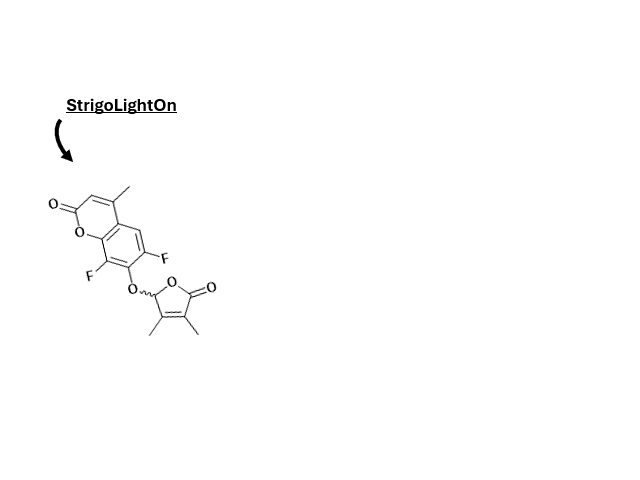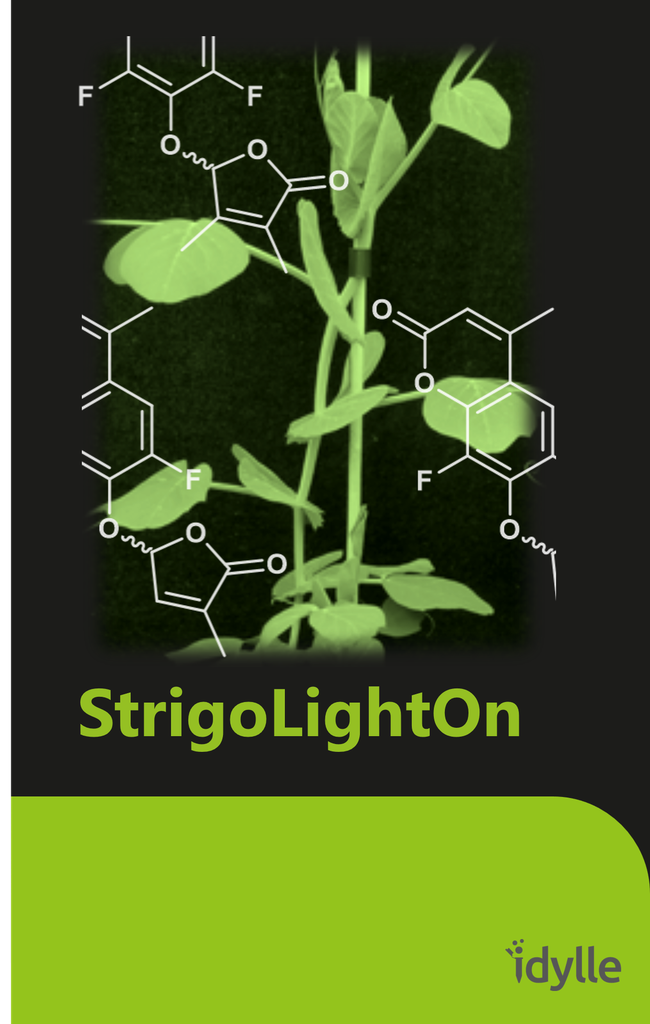- All Products
- Plant biology
- StrigoLightOn - Pro-fluorescent analogs of strigolactones
StrigoLightOn - Pro-fluorescent analogs of strigolactones
https://www.idylle-labs.com/shop/strigolighton-pro-fluorescent-analogs-of-strigolactones-663 https://www.idylle-labs.com/web/image/product.template/663/image_1920?unique=a5f2f64Catalog of pro-fluorescent analogs of strigolactones
A technology developed by
Guillaume Clavé (Institute of Biomolecules Max Mousseron, IBMM, France)
and François-Didier Boyer (Institute of Chemistry of Natural Substances, ICSN, France)
StrigoLightOn compounds are pro-fluorescent strigolactone analogs designed to mimic diverse strigolactone structures. These variants enable deeper insights into receptor-ligand studies by generating more physiologically relevant data.
Simple and real-time tracking of strigolactone receptor activation
Due to their specific design, StrigoLightOn compounds emit fluorescence exclusively upon binding to a strigolactone receptor.
Enhanced versatility in strigolactone mimicry
The availability of three distinct StrigoLightOn variants allows for more accurate replication of natural strigolactone diversity in physiologically meaningful contexts.
Universal model to study strigolactones
StrigoLightOn were shown to bind receptors from D14 and KAI2 family and their bioactivity was tested on many plants.
Description of StrigoLightOn
We offer 3 different molecules with 0, 1 or 2 methylation site on the D-ring that fully represent the variety of strigolactones.
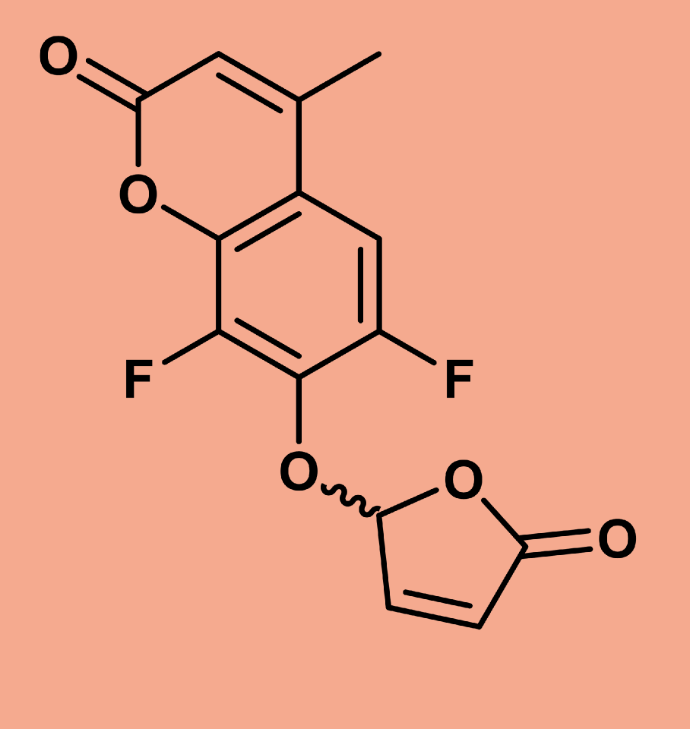
StrigoLightOn-486
The D-ring has no methylation site
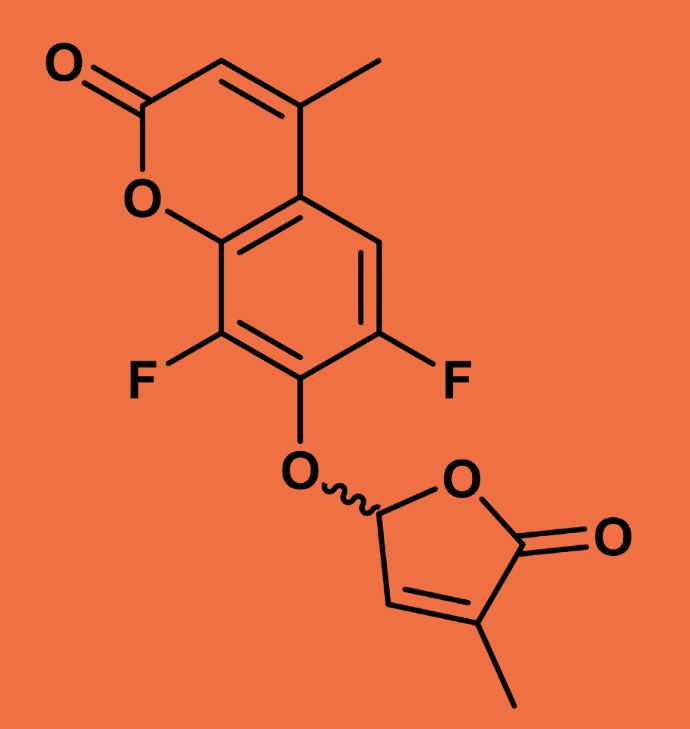
StrigoLightOn-240
The D-ring has one methylation site
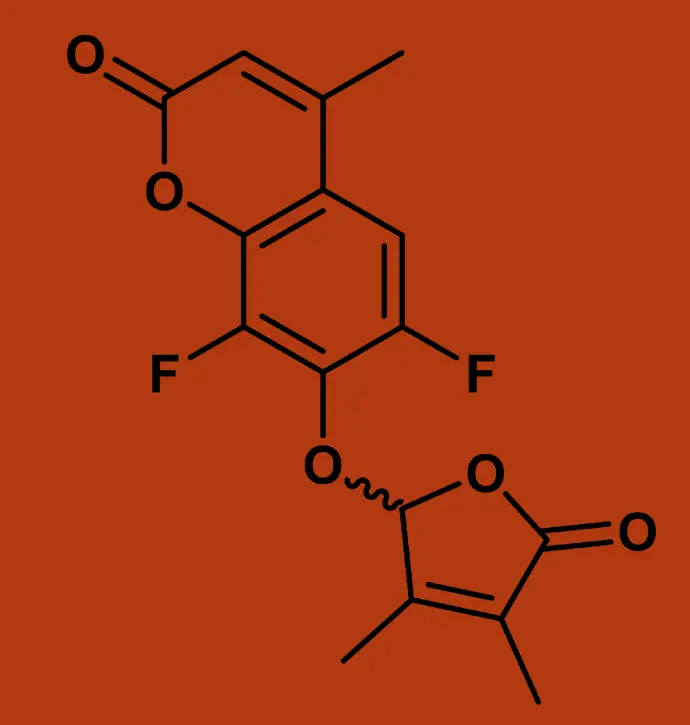
StrigoLightOn-242
The D-ring has two methylation sites
How does StrigoLightOn work ?
StrigoLightOn leverage the operational mechanism of strigolactone receptors.
Upon strigolactone binding, the receptor undergoes hydrolysis, retaining the active moiety covalently while releasing the cargo group—triggering downstream biological functions like protein recruitment.
In the case of our pro-fluorescent analogs, the released molecule becomes fluorescent upon cleavage (hydrolysis) by the receptor. This innovative approach provides a powerful tool for visualizing and studying receptor activity in real-time, offering unparalleled insights into biological processes.

Applications of StrigoLightOn
- Real time monitoring of strigolactone receptor activity through the emitted fluorescence (Previously performed with the following receptors : AtD14, RMS3, OsD14, DAD2, AtKAI2, PrKAI2d3).
- Determination of the affinity of a ligand with competition assay.
- Analysis of strigolactone activity in planta : Bio-activity of StrigoLightOn was previously tested on a variety of plants for their hormonal activity (Arabidopsis Thaliana, Pisum Sativum, Physcomitrella Patens) and parasitic plants for their germination (Pheliplanche Ramosa, Striga Hermonthica).
Kit content of StrigoLightOn
StrigoLightOn are available as 10mM concentrated solutions. To meet various experimental needs, we designed different kit sizes :

Additional information about StrigoLightOn
Storage and stability: Store the solution at -20°C in darkness for year.
Safety data sheets:
Summary of receptor activity determined by StrigoLightOn fluorescence

Fluorescence analysis reveals variations in the response of a single StrigoLightOn across different receptors, as well as differences among multiple StrigoLightOn for a given receptor. These results highlight the importance of having a diversity of analogs, enabling a suitable choice based on the type of receptor being studied.
Data was adapted from De Saint Germain et al 2016, De Saint Germain et al 2021, De Saint Germain et al 2022.
Competition assays can be conveniently conducted by monitoring changes in fluorescence emitted by StrigoLightOn.
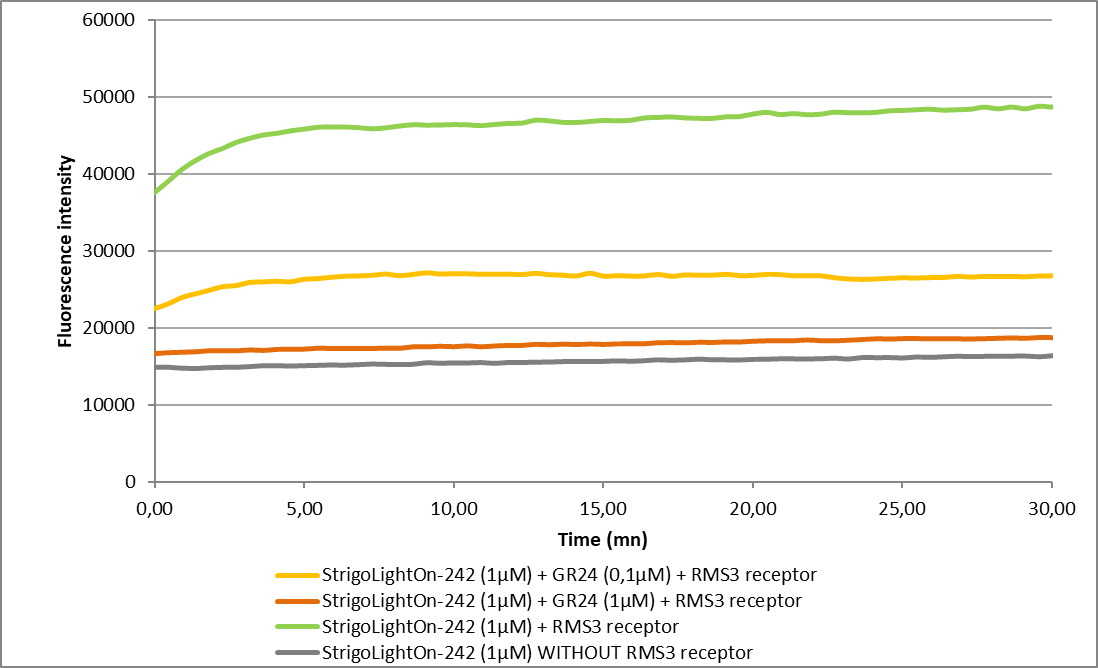
The shift in fluorescence from the beggining of the reaction shows variation of binding of the StrigoLightOn depending on the presence of GR24 and its concentration.
Credit : Guillaume Clavé, Institut des Biomolécules Max Mousseron, France.
StrigoLightOn exhibit strong hormonal bioactivity across multiple plant models
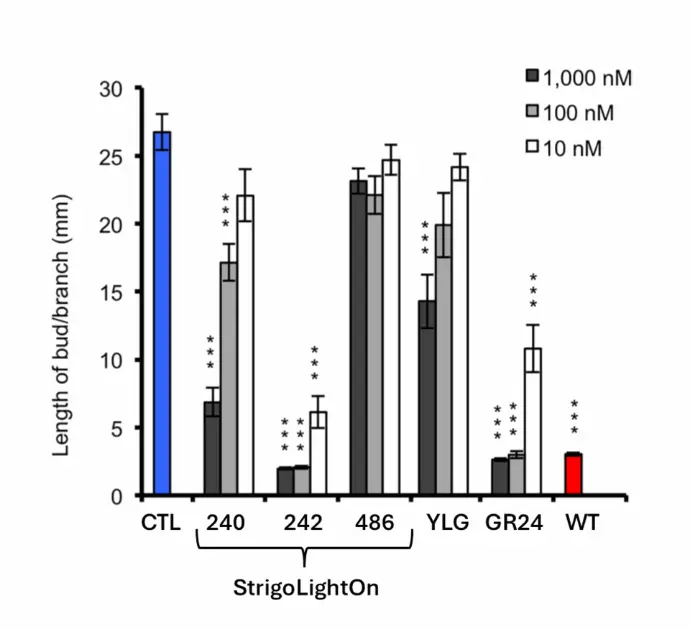
Pisum Sativum
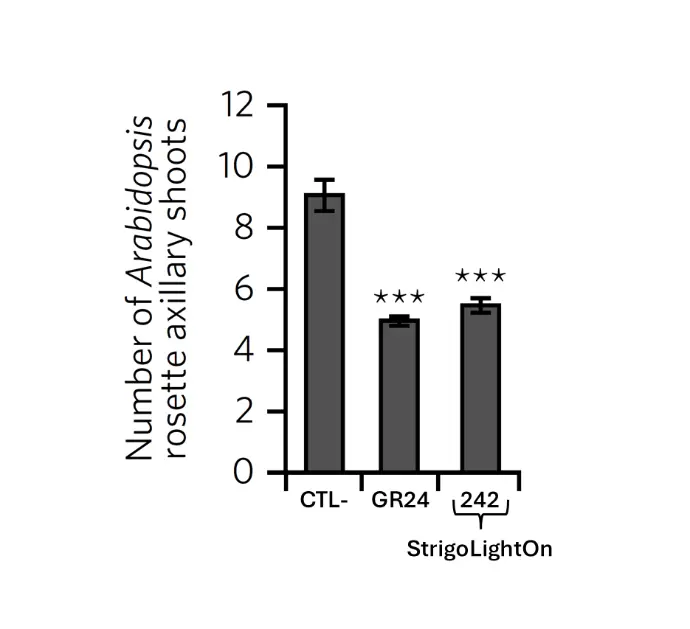
Arabidopsis Thaliana
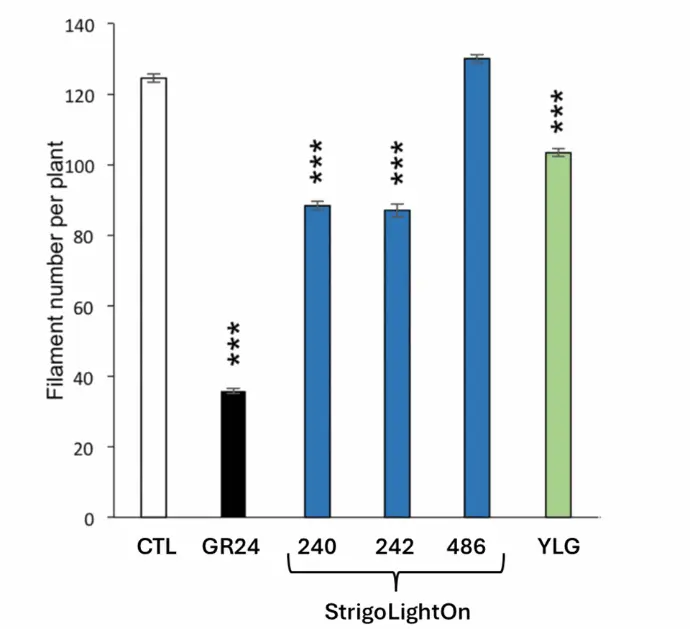 Physcomitrium (Physcomitrella) Patens
Physcomitrium (Physcomitrella) PatensFor each plant tested, there is a StrigoLightOn with bioactivity superior to Yoshimulactone Green (YLG), and/or similar to GR24, a commonly used synthetic strigolactone analog . The various tests conducted on the plants also illustrate variations in the effects of different StrigoLightOn, justifying the use of 3 different analogs that will be more or less active depending on the plant being studied.
Data was adapted from De Saint Germain et al 2016, De Saint Germain et al 2022.
StrigoLightOn can activate germination of parasitic seeds
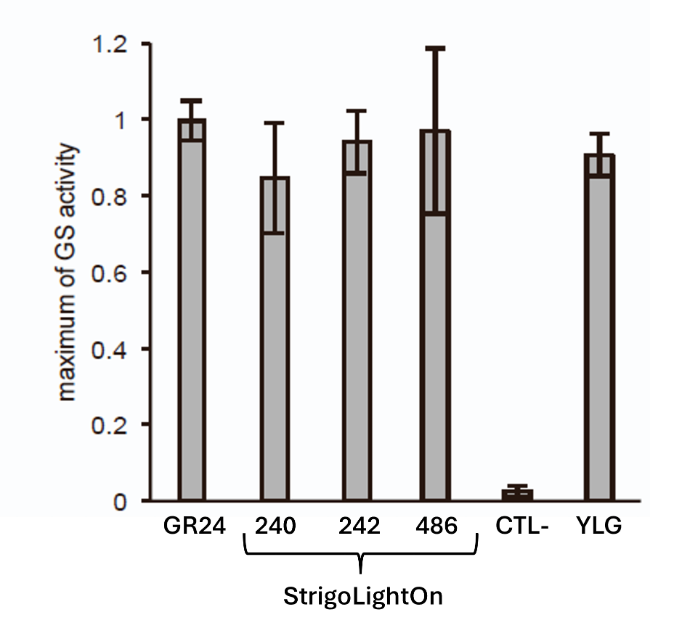
Relative germination stimulant (GS) activity compared to that of GR24
Data was adapted from De Saint Germain et al 2016.
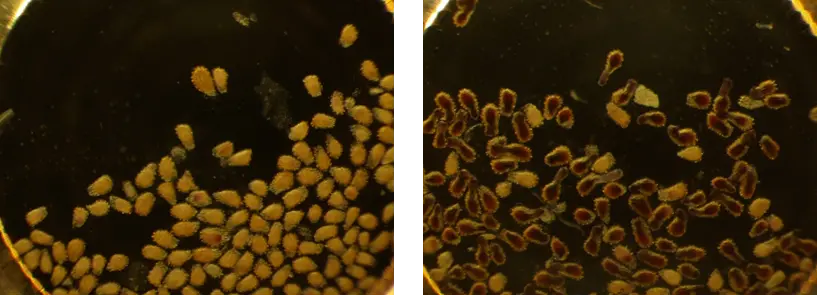
Germination of Pheliplanche Ramosa seeds after incubation with StrigoLightOn-242 (right) compared with control condition (left)
Credit : Jean-Bernard Pouvreau, US2B, Nantes University.
Strigolactones fulfill multiple functions in plants.
When exuded into the soil, they act as signaling molecules that stimulate the germination of parasitic plant seeds, such as those of Striga hermonthica—the genus from which their name is derived. These parasitic species are highly detrimental to numerous major crops worldwide.
In addition to their role in parasitic seed germination, strigolactones also promote beneficial symbiotic interactions between plant roots and arbuscular mycorrhizal fungi, thereby enhancing nutrient acquisition by the host plant.
More recently, strigolactones have been characterized as endogenous plant hormones involved in the regulation of shoot architecture. Specifically, they inhibit axillary bud outgrowth, thus reducing branch number and contributing to a more efficient allocation of resources within the plant.
The bio-activity of StrigoLightOn was previously tested on a variety of plants for their hormonal activity (Arabidopsis Thaliana, Pisum Sativum, Physcomitrella Patens) and on parasitic plants for their germination (Pheliplanche Ramosa, Striga Hermonthica).
For in vitro assay allowing fluorescent measurments, the following receptors were previously used : AtD14, RMS3, OsD14, DAD2, AtKAI2, PrKAI2d3.
If you are specifically interested in a receptor for which the ligand is known, you can mimic the effect more physiologically by choosing the StrigoLightOn that best represent the molecule binding your receptor of interest in vivo. Alternatively, if you are looking for a ligand binding to a receptor, testing the 3 StrigoLightOn might help you in determining its structure.
StrigoLightOn-486 does not have a methyl group and appears more relevant for studying KAI2-type receptors, since its natural ligand is hypothesized to harbour no methyl group.
StrigoLightOn-240 and StrigoLightOn-242, which have one and two methyl groups respectively, more closely resemble the ligands of the D14 receptor orthologs.
For in vitro application, we recommand using StrigoLightOn at 10µM.
For any other questions regarding StrigoLightOn, reach out at [email protected]
The team that originally developped StrigoLightOn have previously published several papers using the probes GC240 (StrigoLightOn-240), GC242 (StrigoLightOn-242) and GC486 (StrigoLightOn-486) :
An histidine covalent receptor and butenolide complex mediates strigolactone perception, Nature Chemical Biology, 2016. Alexandre de Saint Germain, Guillaume Clavé, Marie-Ange Badet-Denisot, Jean-Paul Pillot, David Cornu, Jean-Pierre Le Caer, Marco Burger, Frank Pelissier, Pascal Retailleau, Colin Turnbull, Sandrine Bonhomme, Joanne Chory, Catherine Rameau and François-Didier Boyer. (https://doi.org/10.1038/nchembio.2147)
A Phelipanche ramosa KAI2 protein perceives strigolactones and isothiocyanates enzymatically, Plant Communications, 2021. Alexandre de Saint Germain, Anse Jacobs, Guillaume Brun, Jean-Bernard Pouvreau, Lukas Braem, David Cornu, Guillaume Clavé, Emmanuelle Baudu, Vincent Steinmetz, Vincent Servajean, Susann Wicke, Kris Gevaert, Philippe Simier, Sofie Goormachtig, Philippe Delavault, François-Didier Boyer. (https://doi.org/10.1016/j.xplc.2021.100166)
Expansion of the Strigolactone Profluorescent Probes Repertory: The Right Probe for the Right Application, Frontiers in Plant Science, 2022. Alexandre de Saint Germain, Guillaume Clavé, Paul Schouveiler, Jean-Paul Pillot, Abhay-Veer Singh, Arnaud Chevalier, Suzanne Daignan Fornier, Ambre Guillory, Sandrine Bonhomme, Catherine Rameau and François-Didier Boyer. (https://doi.org/10.3389/fpls.2022.887347)
Synthesis of Profluorescent Strigolactone Probes for Biochemical Studies, Springer Protocole, 2021. Alexandre de Saint Germain, Guillaume Clavé and François-Didier Boyer.(http://doi.org/10.1007/978-1-0716-1429-7_17)
Start with the customer – find out what they want and give it to them.
Start with the customer – find out what they want and give it to them.
Start with the customer – find out what they want and give it to them.
Start with the customer – find out what they want and give it to them.

